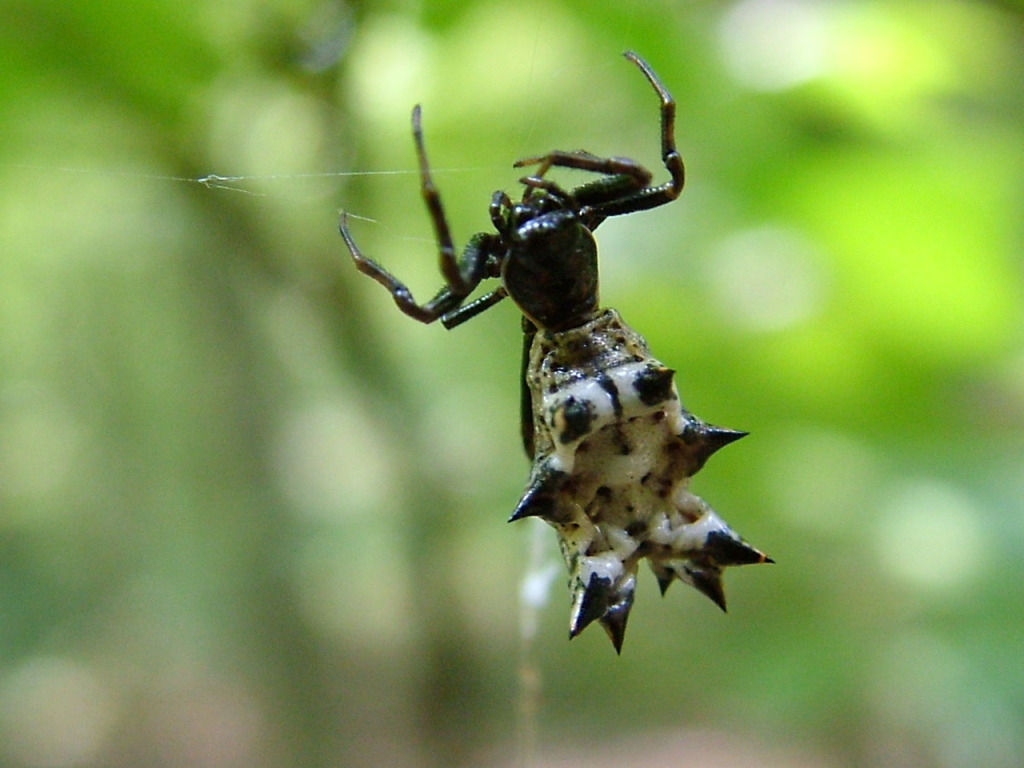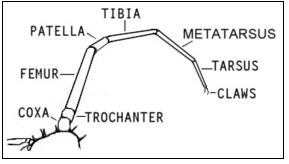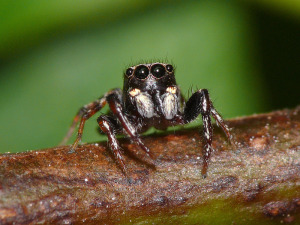Spider Legs: Hydraulics in Action

How Spider Legs Work
Let's face it, spiders are considered creepy by a large majority of people around the world. Yet when you ask them, most folks can't really name what it is about spiders that freaks them out so much. Usually explanations start with beady eyes, fangs, bites, or wrapping up their prey. Spider movement is also at the top of the list. They scuttle and scurry around at night (especially when you turn on the lights and they scamper off), jump, and generally run in a "creepy" way. But what makes their movement really foreign and creepy to us? The answer lies in two key elements of their anatomy, their skeleton and muscles.
First, check out this short video of a spider walking, to give you some context:
Spiders are arthropods, which literally means "joint footed". Like all arthropods they lack bones and an internal skeleton. Instead they have a hard outer skeleton called an exoskeleton. This exoskeleton is made out of chitin, something similar to our fingernails and hair. It's super strong and light. But how does this relate to their creepy-cool movement? Spiders don't have internal bones, which means they don't have the same muscles and attachments that vertebrates have.

In the body of vertebrates, like humans, there are three types of muscles. These are cardiac (heart), visceral (internal organs), or skeletal. The bones of our skeleton are moved by muscles which attach directly to each bone in antagonistic pairs. These are are flexors and extensors. The contraction of flexor muscles causes a joint to bend (think of 'flexing your muscle'), while extensors cause a joint to open. Flexors and extensors give us smoth motion in the movement in our muscles. Spiders don't have this same movement.

Humans only have one major joint per limb (knee, elbow, etc), but spiders have seven joints for each leg. The upshot to having a multi jointed exoskeleton is that spiders don't have the support of bones for a flotilla of flexors and extensors. There isn't enough room inside their bodies for attachment, and even if there was, all those muscles would make them super heavy and lumbering. On top of that spiders wouldn't have enough energy to keep those muscles warm (it's rough being a "cold blooded" creature) nor enough oxygen to support a large number of muscles.
So if spiders can naturally flex their limbs inward, how do they push their legs outward to run, jump, and move without extensors? The answer is hydraulic pressure. A skeleton's body is filled with a fluid that is like blood (though some what different) called hemolymph. If you remember, spiders only have two body parts, the first is the fused head and middle, called a cephalothorax (#2 below). The other is their abdomen (#3).

All eight spider legs are attached to the cephalothroax for a good reason. Each leg's outward movement is controlled through the cephalothroax, which regulates the hydraulic movement and pressure hemolymph. Spiders don't need extensor muscles because they can use fluid movement/hydraulics to "push" out their legs. The cephalothorax acts something like a very finely-tuned, fluid-filled bellows that pushes hemolymph around the body of the spider in a fraction of a second. The flexor muscles in the spider's legs naturally want to contract, but the hydraulic pressure allows the legs to move outward and resist this contraction. Have you ever seen a dead spider with all eight legs curled up? (yes, I know, most of you cheered) This is because when the spider dies its legs naturally contract due to the flexor muscles lacking hydrostatic resistance.
Don't think that just because spiders don't have sets of flexors and extensors that they can't move efficiently. As most of you know they can move quite fast. Jumping spiders (~1-20 mm in length) are thought to be able to jump between 30 and 40 times their own length!

One of the reasons that spiders are naturally skittish and afraid of humans (read predators) is because they rely on hydrostatic pressure in their skeleton. If they are punctured or lose a leg, they they risk losing their pressure and literally deflating. In some species there are checks or valves in their legs to prevent deflation, but if they lose enough hemolymph the wouldn't be able to move. Their main body is also very vulnerable to puncturing and even death.
The other upshot to having an exoskeleton (which all of you arachnophobes will love) is that spiders can't grow to be very big. In part it's because hydraulics of this nature and their affiliate exoskeletons can't support land animals that are very large. Check out my post on "Killer 50 Foot Cockroaches" for more.
SPIDERS AND BIOMIMICRY
As regular readers of my blog know I adore biomimicry, a field of science and engineering dedicated to modeling solutions from nature. Spider hydraulics are currently being studied by researchers to see if they can create robots that move like spiders do. If you haven't read my post on biomimicry and 3D printers, check it out here.

Currently, researchers have created a small robot, made from a 3D printer, that uses hydraulics and pneumatics to jump and crawl. Just like a real spider, the robots legs are controlled through hydraulic pumps in the abdomen of the machine. Now before you get all creeped out, think about the applications of such a machine. Humans could search through rubble and debris in buildings quickly, send robot spiders into hostage situations, scout clogged drains and sewers, go into dangerous mines, or probe caves. Spider movement may seem creepy to you, but there is some great technology that can be developed by mimicking spiders.
SPIDER HYDRAULICS LESSONS
The awesome thing about spiders, and their movement, is that you can combine lessons on biology, anatomy, physiology, hydraulics, and pneumatics into an engineering activity for 5-8th grade. I modified a lesson on hydraulic arms to teach about spiders. It can be as simple as using syringes, water, popsicle sticks, hot glue, beads, aquarium hose, and zip ties. My favorite site was "Easy Hydraulic Machines" from the Instructables website. They have step by step instructions and a downloadable PDF.

For my classes I started with a quick lesson on spider anatomy, then hydraulics and pneumatics (using syringes and hoses). Next I had students work in groups, and gave them supplies, without building instructions. I had them come up with suggestions for a hydraulic arm, including the criteria and constraints of the project (and yes, this aligns with Next Generation Science Standards). They had to draw a design, figure out materials, develop a concept of how the arm should work and then after approval build the arm. It can take two or three class periods, depending on if you want to have "lifting" challenges.
Here's a short video from the Instructables website, that gives you some ideas:
The beauty of this project is that it can also be done at home, for home school, or just for fun over the holidays. You can even buy hydraulic kits online. There is no end to the creativity!

Even though spiders can be thought of as creepy, I see them as creepy-cool. They offer us a wealth of information and learning, from how they spin a material that is stronger than steel cable, to how they move. Hopefully now you too will have a greater respect for the humble spider, and let him crawl on his way.

